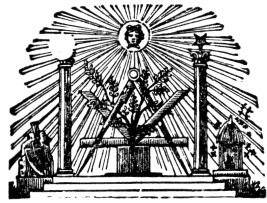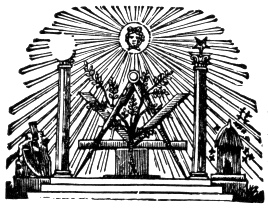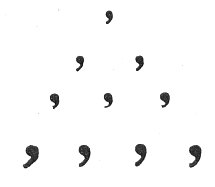A. The Worshipful Master approaching me from the east, under the duegard and sign of a Fellow Craft; who, in token of the continuance of his brotherly love and favor, presented me with his right hand, and with it the pass, token, token of the pass, grip and word of a Fellow Craft, and ordered me to arise and salute the Junior and Senior Warden as such.
Q. After saluting the Wardens, what did you then discover?
A. The Worshipful Master ordered me to the Senior Warden in the west, who taught me to wear my apron as a Fellow Craft.
Q. How should a Fellow Craft wear his apron?
A. With the flap turned down, and the corner turned up.
Q. After being taught to wear your apron as a Fellow Craft, how were you then disposed of?
p. 82
A. I was conducted to the Worshipful Master in the east, who presented me with the working-tools of a Fellow Craft (the plumb, square, and level), and taught me their use.
Q. What is their use?
A. The plumb is an instrument made use of, by operative masons, to raise perpendiculars; the square, to square their work; and the level, to lay horizontals. But we, as Free and Accepted Masons are taught to make use of them for more noble and glorious purposes: the plumb admonishes us to walk upright, in our several stations, before God and man; squaring our actions by the square of virtue; and remembering that we are travelling, upon the level of time, to “that undiscovered country from whose bourne no traveller returns.”
Q. How were you then disposed of?
A. I was ordered to be returned to the place from whence I came, and invested of what I had been divested of, and was informed that, agreeably to an ancient custom in every well-governed Lodge, it therefore became necessary that I should make a regular ascent, by a flight of winding stairs, consisting of three, five, and seven steps, to a place representing the Middle Chamber of King Solomon’s Temple, there to receive instructions relative to the wages and jewels of a Fellow Craft.
SECOND SECTION.
Q. Have you ever worked as a Fellow Craft?
A. I have, in speculative; but our forefathers wrought in both speculative and operative Masonry.
Q. Where did they work?
A. At the building of King Solomon’s Temple, and of many other Masonic edifices.
Q. How long did they work?
A. Six days.
Q. Did they work on the seventh?
A. They did not.
Q. Why so?
A. Because in six days God created the heavens and the earth, and rested on the seventh day; the seventh day, therefore, our ancient brethren consecrated as a day of rest from their labors, thereby enjoying more frequent opportunities to contemplate the glorious works of creation, and adore their great Creator.
Q. Did you ever return to the sanctum sanctorum, or holy of holies, or King Solomon’s Temple?
p. 83
A. I did.
Q. By what way?
A. Through a long porch or alley.
Q. Did any thing in particular strike your attention on your return?
A. There did, viz.: two large columns, or pillars, one on the left hand, and the other on the right.
Q. What was the name of the one on the left hand?
A. Boaz, which denotes strength.
Q. What was the name of the one on the right hand?
A. Jachin, denoting establishment.
Q. What do they collectively allude to?
A. A passage in Scripture, wherein God has declared in his word, “In strength shall this house be established.”
Q. What were their dimensions?
A. Thirty-five cubits in height, twelve in circumference, and four in diameter.
Q. Were they adorned with any thing?
A. They were; with two large chapiters, one on each.
Q. What was the height of these chapiters?
A. Five cubits.
Q. Were they adorned with any thing?
A. They were; with wreaths of net-work, lily-work, and pomegranates.
Q. What do they denote?
A. Unity, Peace, and Plenty.
Q. Why so?
A. Net-work, from its connection, denotes union; lily-work, from its whiteness and purity, denotes peace; and pomegranates, from the exuberance of their seed, denote plenty.

Moe is the founder of GnosticWarrior.com. He is a father, husband, author, martial arts black belt, and an expert in Gnosticism, the occult, and esotericism.




